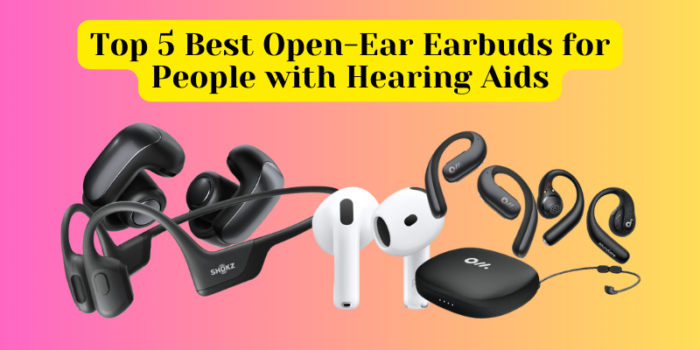Have you ever struggled to find earbuds that work seamlessly with hearing aids without causing discomfort or audio interference? You’re not alone.
Traditional earbuds often present challenges for those with hearing impairments, from poor fit to frustrating feedback. Fortunately, open-ear earbuds offer a game-changing solution, allowing users to enjoy their favorite music or podcasts while staying aware of their surroundings. With the rising popularity of bone conduction technology, these innovative earbuds are now recognized as some of the best open-ear earbuds for people with hearing aids.
Designed to deliver sound through the cheekbones or just outside the ear canal, open-ear earbuds let you stay connected to the world around you without blocking out essential environmental sounds. This makes them ideal for individuals who need to maintain situational awareness, whether at work, home, or during outdoor activities.
In this guide, we’ll walk you through the top choices in the market, from Shokz to Bose, and explain why these products stand out. So, if you have been wondering, “What are the best headphones for hearing aid users?” join us as we explore the best open-ear earbuds to help you make an informed choice.
Key Takeaways:
- Open-ear earbuds provide a comfortable listening experience for hearing aid users without obstructing the ear canal.
- Bone conduction and air conduction technologies offer different benefits, with bone conduction being ideal for maintaining situational awareness.
- The right fit and proper volume adjustment can help avoid audio feedback and discomfort.
- Top options include Shokz OpenRun Pro, Bose Ultra, Oladance OWS Pro, Soundcore AeroFit Pro, and Apple AirPods 4.
- Consult an audiologist to ensure compatibility with your specific hearing aids.
- Open-ear earbuds allow users to enjoy audio while staying aware of their surroundings.
What Are Open-Ear Earbuds?
First, let’s get some basic understanding of what open-ear earbuds are.
Open-ear earbuds are a unique type of audio device that allows you to listen to sound without blocking your ear canal. They often use bone conduction technology, which transmits audio through your cheekbones, bypassing the eardrum and leaving your ears unobstructed. This non-intrusive design means you can still hear ambient sounds, making it easier to stay aware of your surroundings. Unlike traditional earbuds that sit inside the ear canal, open-ear earbuds rest outside the ears, providing a comfortable and secure fit without causing irritation or discomfort.
The main advantage of open-ear designs is that they don’t interfere with hearing aids. For individuals who use in-the-ear or behind-the-ear hearing aids, the absence of a bud in the ear canal eliminates audio interference and fitting issues. This seamless integration allows users to wear both devices simultaneously, enhancing their listening experience.
Why They Are Beneficial for Hearing Aid Users
Open-ear earbuds offer several benefits that make them ideal for people with hearing aids:
- Compatibility: They work well with various hearing aid styles, including in-the-ear, behind-the-ear, and receiver-in-canal devices.
- Reduced Feedback: By not blocking the ear canal, open-ear earbuds help minimize the risk of audio feedback or whistling sounds that can occur when sound waves interfere with hearing aids.
- Environmental Awareness: Keeping the ears open enables users to stay aware of external sounds, such as traffic or conversations, providing a safer listening experience.
Open-Ear vs. Traditional Earbuds
While traditional earbuds can deliver high-quality sound, they pose several problems for hearing aid users:
- Fitting Issues: The bulky design of standard earbuds can cause discomfort, especially when paired with hearing aids.
- Audio Feedback: Sealing the ear canal can lead to interference, making it challenging to achieve clear sound.
- Limited Awareness: Conventional earbuds can block out important background noise, reducing situational awareness.
For these reasons, open-ear earbuds have emerged as a superior choice, offering a balance of comfort, sound quality, and safety for those who wear hearing aids.
Key Considerations When Choosing Open-Ear Earbuds for Hearing Aid Users
1. Compatibility with Hearing Aid Type
When selecting open-ear earbuds, it's crucial to consider how they will interact with your specific hearing aid design. There are three primary hearing aid styles:
- In-the-ear (ITE): These devices sit entirely in the ear canal, and using traditional earbuds can cause discomfort or feedback issues. Open-ear models can eliminate these problems by resting outside the ear.
- Behind-the-ear (BTE): Since BTE devices rest behind the ear, open-ear earbuds can be worn without disturbing the hearing aid, allowing both to function effectively.
- Receiver-in-canal (RIC): These hearing aids have a receiver placed inside the ear canal, connected to the main body behind the ear. Open-ear earbuds accommodate this design, reducing interference and ensuring a snug fit.
Ensuring compatibility with your hearing aid type will help you get the most out of your listening experience.
2. Bone Conduction vs. Air Conduction
There are two main technologies in open-ear listening: bone conduction and air conduction:
- Bone conduction headphones transmit sound through the cheekbones, bypassing the eardrum entirely. This method is ideal for hearing aid users because it allows ambient noise to reach the ears while providing clear audio.
- Air conduction earbuds, on the other hand, project sound directly toward the ear without blocking the ear canal. Although they don’t offer the same level of clarity in noisy environments, they still provide a comfortable, non-intrusive listening experience.
Both options can be suitable for hearing aid users, depending on personal preferences and specific listening needs.
3. Battery Life and Charging
Battery life is an important consideration, especially if you plan to use both hearing aids and earbuds throughout the day. Look for models that offer extended battery life, quick-charging features, or even a charging case for on-the-go use. Remember that frequent simultaneous use of hearing aids and earbuds can deplete battery life more quickly.
4. Sound Quality and Volume Control
For hearing aid wearers, sound quality and volume control are critical. Choose earbuds that provide good audio clarity for both music and voice, allowing for easy adjustment of volume levels. This ensures that you can enjoy your audio content without compromising on hearing aid performance, keeping speech intelligible and music enjoyable.
Top 5 Best Open-Ear Earbuds for People with Hearing Aids
When it comes to choosing the best open-ear earbuds for hearing aid users, the following options stand out. These earbuds cater to various needs, including comfort, sound quality, and ease of use, making them ideal for individuals who require both a hearing aid and audio device.
1. Shokz OpenRun Pro
SHOKZ OpenRun Pro - Open-Ear Bluetooth Bone Conduction Sport Headphones
Experience premium audio delivered through your cheekbone with our 9th bone conduction technology. Engineered with Shokz TurboPitch technology, OpenRun Pro headset features our best listening experience with clear sound, powerful volume, and a rich bass
The Shokz OpenRun Pro is a lightweight, open-ear Bluetooth headset designed for those who enjoy active lifestyles. It features bone conduction technology, which delivers sound through the cheekbones, allowing users to stay aware of their surroundings. With a flexible, wraparound design, these earbuds offer a secure and comfortable fit, even for those who wear glasses.
Pros:
- Lightweight and Flexible: The titanium frame ensures a snug fit without adding bulk.
- Durable: IP54 rating for dust and water resistance makes it suitable for various environments, including workouts and outdoor activities.
- Battery Life: Provides up to 7 hours of playback on a single charge, with a 5-minute quick charge offering an extra 1.5 hours.
- Bluetooth Multipoint: Allows easy switching between two devices, such as a phone and a laptop.
Cons:
- Bass Performance: While adequate for casual listening, the bass may feel underwhelming for genres like hip-hop or EDM.
- Fit Limitations: Some users may find the fit uncomfortable if wearing the headset for extended periods.
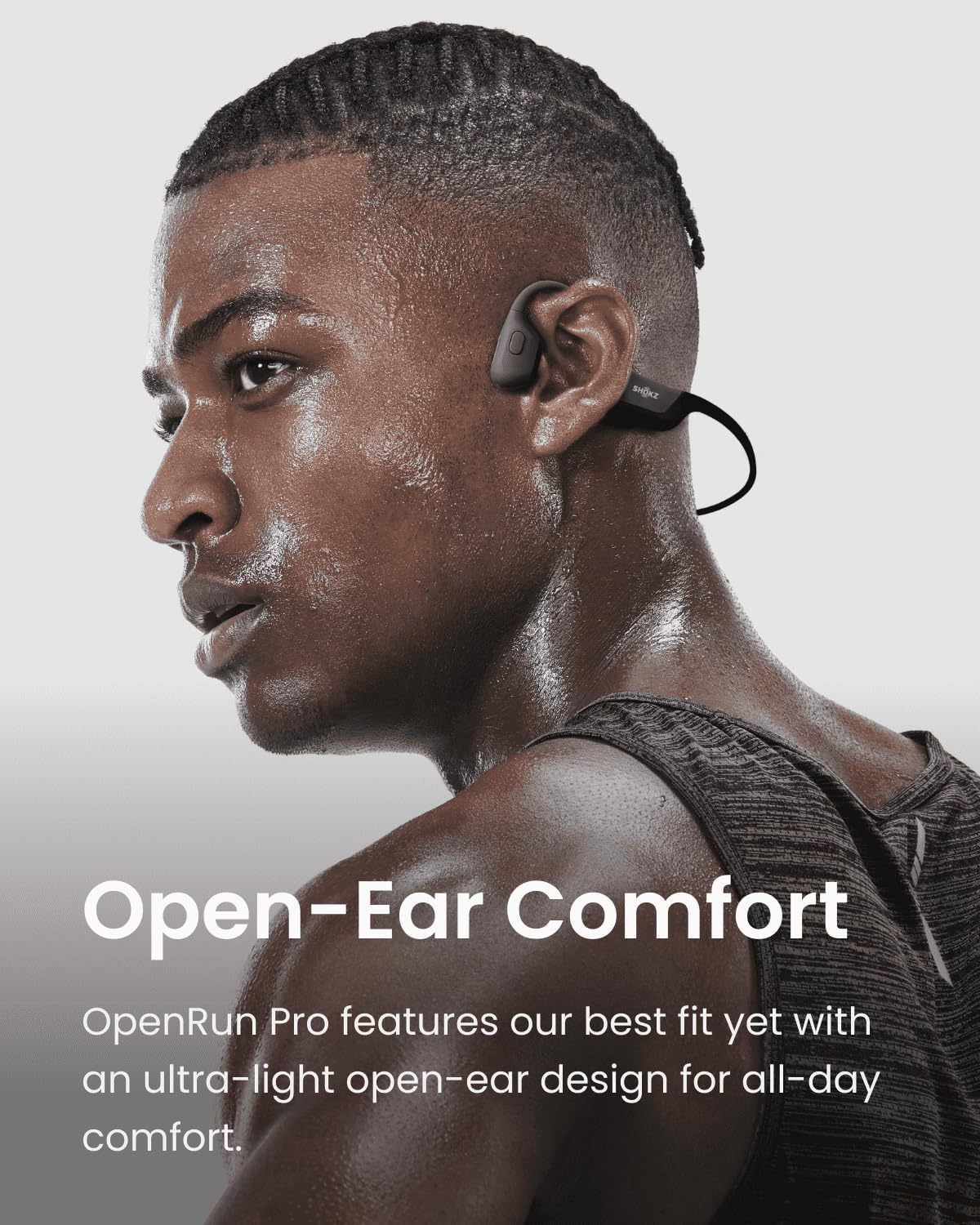
Why It’s Recommended for Hearing Aid Users:
The Shokz OpenRun Pro’s bone conduction technology makes it particularly useful for people with hearing aids, as it doesn't obstruct the ear canal. This ensures that users can hear their surroundings and avoid audio feedback issues often associated with traditional earbuds. Its durable, lightweight design allows for comfortable use during various activities, making it ideal for active individuals.
Price Range:
Mid-range, typically priced between $139 and $179, depending on the retailer.
2. Bose Ultra Open Earbuds
Bose Ultra Open Earbuds, Immersive Audio Open Ear Earbuds
With Bose Immersive Audio spatialized sound, these Bluetooth earbuds feel, look good, and bring you closer to your music, so you’re not only listening, you’re in it
The Bose Ultra Open Earbuds are designed to provide a premium listening experience without compromising awareness of the surrounding environment. These clip-on earbuds utilize Bose's proprietary OpenAudio technology to deliver immersive sound, while their unique design ensures a secure fit around the ear.
Pros:
- Superior Sound Quality: Offers rich audio with clear highs, balanced mids, and strong bass, thanks to spatial audio capabilities.
- Comfortable Fit: The flexible ear cuff design fits gently around the ear, making it more comfortable than traditional earbuds for extended wear.
- Water Resistance: Rated IPX4, making them suitable for use during light rain or sweat-inducing activities.
- Extended Battery Life: Offers up to 7 hours of playtime per charge, with up to 48 hours of standby. The charging case provides an additional 2.5 full charges.
Cons:
- Premium Price: At around $299, these are more expensive than many other open-ear options.
- Call Quality Limitations: Some users report poor microphone performance during calls.

Why It’s Recommended for Hearing Aid Users:
The Bose Ultra Open Earbuds excel in providing high-quality audio without obstructing the ear canal, making them compatible with various hearing aid styles. The clip-on design ensures that the earbuds remain securely in place, even for users who wear glasses or participate in active sports. The ability to maintain awareness while enjoying immersive audio makes these earbuds a great choice for hearing aid users who prioritize sound quality.
Price Range:
Premium, with a typical price of $299, reflecting its advanced audio features and brand reputation.
3. Oladance OWS Pro
Oladance OWS Pro Open Ear Bluetooth Headphones with Multipoint Connection
With the 150mAh high-density steel battery and the latest Energy Lock technology, Oladance OWS Pro Bluetooth headphones provide 16 hours of continuous playback per charge and extra 42 hours by using the charging case.
The Oladance OWS Pro is a true open-ear Bluetooth headphone that aims to deliver a natural listening experience while keeping your surroundings audible. Unlike bone conduction models, the OWS Pro utilizes air conduction technology, projecting sound directly toward the ear without sealing the ear canal. The design ensures comfort and situational awareness, making it suitable for extended wear.
Pros:
- Open-Ear Design: Allows for ambient sound awareness, ensuring safety during outdoor activities.
- High-Quality Audio: Provides clear sound and balanced audio with dual 23mm drivers, comparable to wired headphones in quieter environments.
- Customizable Sound: The companion app offers an equalizer for fine-tuning sound preferences to suit different listening needs.
- Excellent Battery Life: Capable of up to 58 hours of total playtime with the charging case, including 16 hours per charge and a quick-charge feature providing 6 hours after 15 minutes of charging.
- Multipoint Connectivity: Supports simultaneous pairing with two devices, allowing seamless switching between them.
Cons:
- Not Suitable for High-Intensity Activities: While comfortable, the ear hooks may not stay secure during vigorous movements like yoga inversions or high-impact sports.
- Reduced Bass Performance: As with many open-ear models, the bass is not as pronounced as in closed-back headphones.
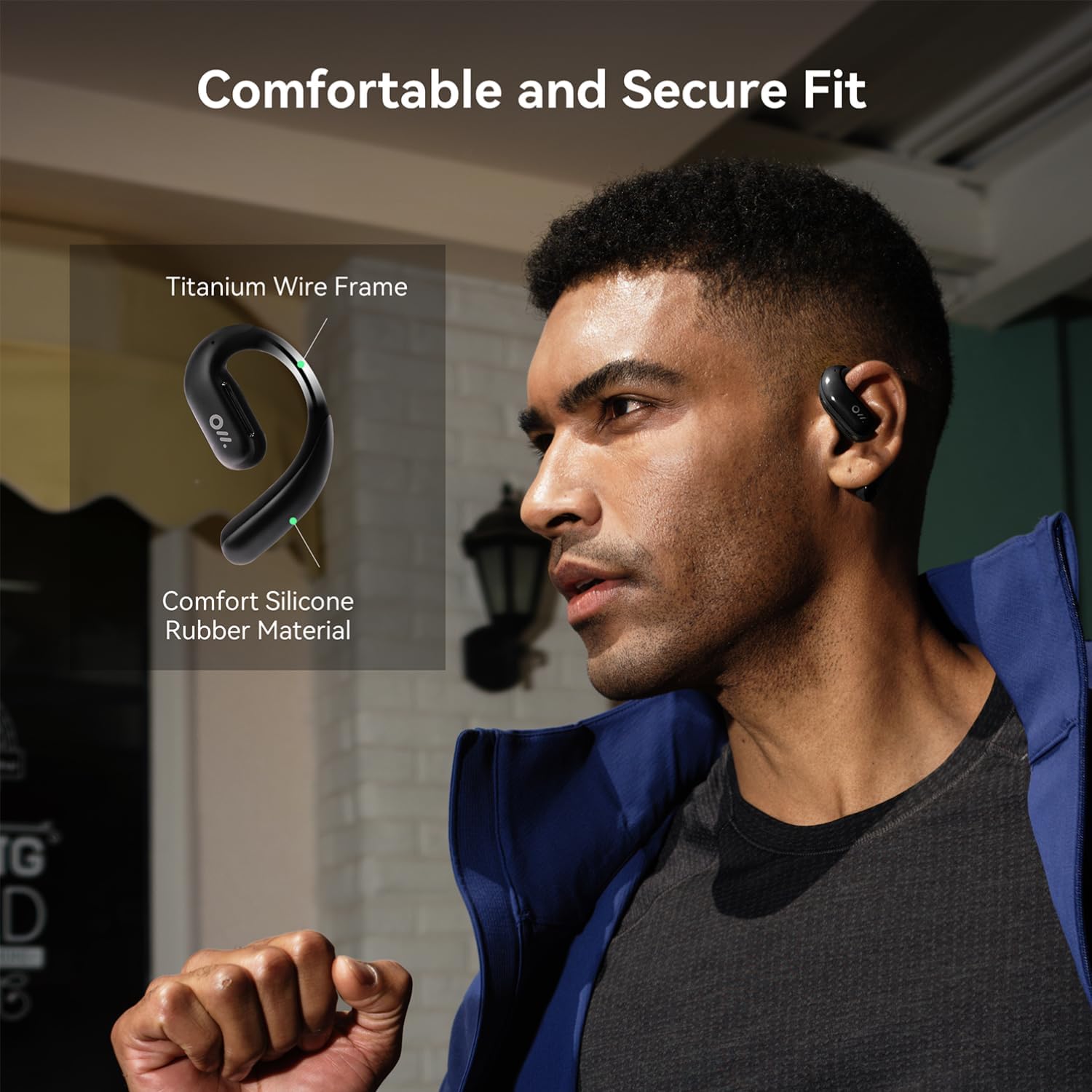
Why It’s Recommended for Hearing Aid Users:
The Oladance OWS Pro’s air conduction technology allows users to keep their ears open while enjoying high-quality audio, making it compatible with different hearing aid types, including in-the-ear and behind-the-ear devices. The ergonomic design offers a comfortable fit for long wear, while the customizable sound settings provide better control over audio preferences. These features make the OWS Pro a great choice for individuals seeking a non-intrusive listening experience without compromising on sound quality.
Price Range:
Mid-range, typically priced between $129 and $169, offering a balance of quality and affordability.
4. Soundcore AeroFit Pro
Soundcore by Anker AeroFit Pro Open-Ear Headphones
Experience unparalleled sound with a 16.2mm titanium-coated diaphragm and LDAC technology, delivering three times more data for a truly immersive audio adventure with Uncompromising Sound quality.
The Soundcore AeroFit Pro is an open-ear headphone designed for users who value comfort and sound quality during active use. With LDAC technology, it offers Hi-Res audio over Bluetooth, making it a top contender for those who seek immersive audio experiences without sacrificing awareness of their environment. The titanium-coated diaphragm and ergonomic design ensure a secure and comfortable fit.
Pros:
- Stylish and Ergonomic: Features a sleek design with a titanium memory wire ear hook for a stable fit.
- Impressive Battery Life: Offers up to 14 hours of playtime on a single charge, with an additional 46 hours provided by the charging case.
- Water and Sweat Resistant: Rated IP55, suitable for intense workouts and outdoor activities.
- Superior Sound Quality: The 16.2mm drivers and LDAC technology deliver rich, detailed audio across all frequencies.
- User-Friendly Controls: Physical button controls allow for easy adjustment during workouts or while on the go.
Cons:
- Sound Isolation Limitations: As an open-ear model, it doesn’t provide noise cancellation, which may be a drawback in very noisy environments.
- Multipoint Connectivity Requires Configuration: Needs a manual setup to connect to multiple devices, which could be more user-friendly.
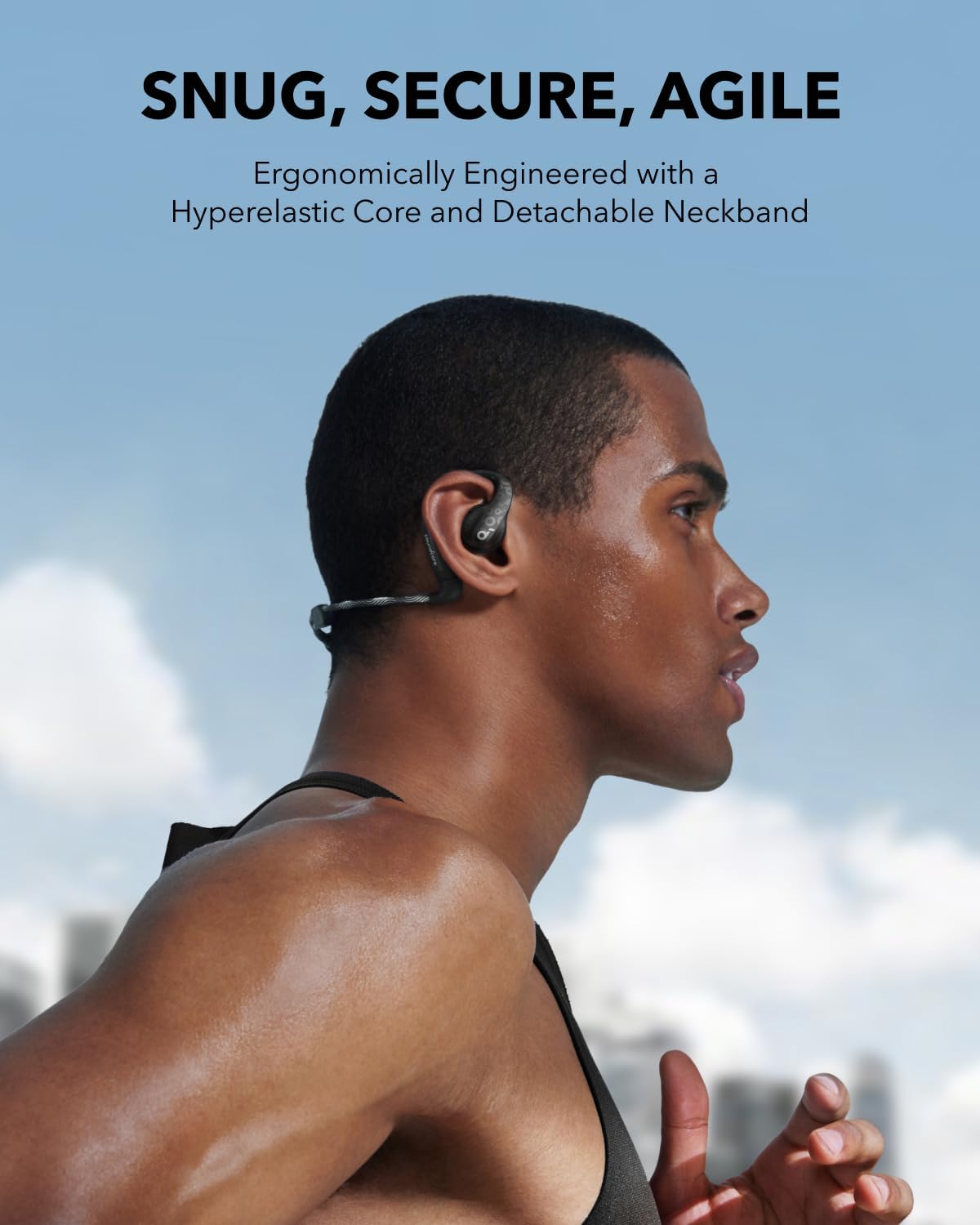
Why It’s Recommended for Hearing Aid Users:
The Soundcore AeroFit Pro provides a comfortable and secure fit that won’t interfere with behind-the-ear hearing aids, making it suitable for users who are physically active. Its open-ear air conduction design keeps the ear canal clear, allowing ambient sounds to come through while providing high-quality audio for music and calls. The combination of long battery life, durability, and easy-to-use controls makes it a practical choice for individuals who wear hearing aids.
Price Range:
Budget to mid-range, usually available for $99 to $179, making it an affordable option with premium features.
5. Apple AirPods 4 (with ANC)
Apple AirPods 4 Wireless Earbuds
AirPods 4 have been redesigned for exceptional all-day comfort and greater stability. With a refined contour, shorter stem, and quick-press controls for music or calls.
The Apple AirPods 4 brings the familiar Apple design to the next level with enhanced Active Noise Cancellation (ANC) and a comfortable fit. These earbuds cater to users who value both high-quality sound and seamless integration with Apple devices.
The AirPods 4 features a refined contour with a shorter stem, providing a more stable fit compared to previous models. With Adaptive Audio and Personalized Spatial Audio, the AirPods 4 delivers an immersive listening experience without obstructing the ear canal.
Pros:
- Improved Sound Quality: Offers a richer and more detailed audio experience than earlier models, with effective ANC that enhances music and voice clarity.
- Comfortable Fit: The familiar design is suitable for casual use, providing a secure fit without inserting deeply into the ear canal.
- Advanced Features: Includes Adaptive Audio, which seamlessly blends ANC and Transparency Mode, allowing users to interact with their environment without needing to remove the earbuds.
- Multi-Device Compatibility: Easily switches between Apple devices, providing a user-friendly experience for those within the Apple ecosystem.
- Wireless Charging: Comes with a USB-C charging case that supports wireless charging, making it convenient for on-the-go use.
Cons:
- Limited Customization: Compared to some competitors, the AirPods 4 lacks an extensive equalizer for sound personalization.
- High Price Point: As a premium Apple product, it is more expensive than many alternatives.
- Not Designed for Intense Activities: While suitable for everyday use, the fit may not be ideal for vigorous sports or workouts.
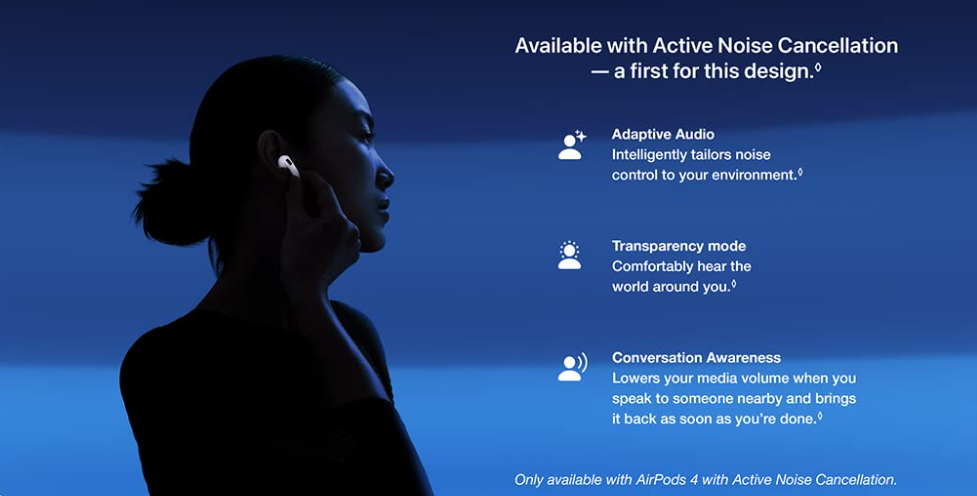
Why It’s Recommended for Hearing Aid Users:
The AirPods 4 stand out for their ability to combine high-quality audio with an open-ear design that maintains environmental awareness. The ANC feature is useful for reducing background noise without sealing the ear canal, making it compatible with various hearing aids, such as behind-the-ear and in-the-ear models. Additionally, the Adaptive Audio ensures that users can stay engaged with their surroundings, switching between Transparency Mode and ANC as needed.
Price Range:
Premium, typically priced at around $249 to $299, reflecting its advanced technology and seamless integration with Apple devices.
Comparing Bone Conduction and Air Conduction Open-Ear Earbuds
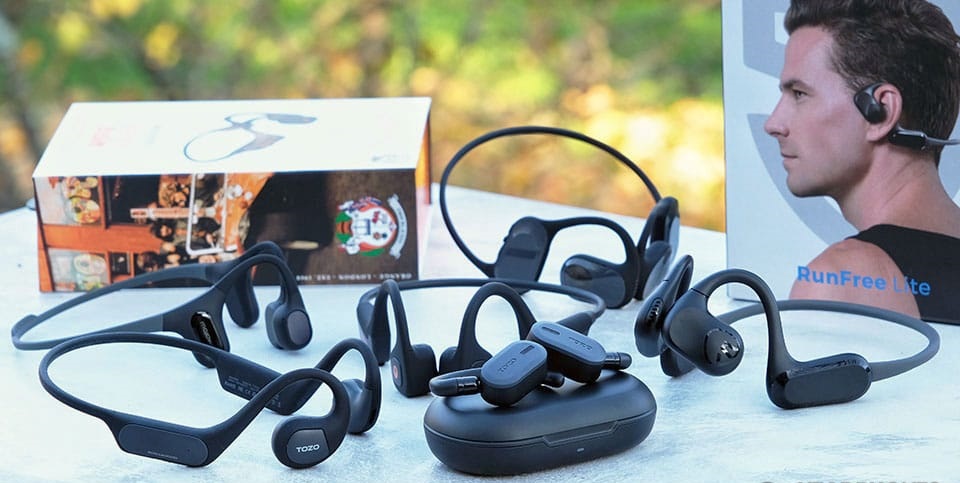
Bone conduction and air conduction represent two distinct approaches in open-ear listening technology. While both allow users to hear their surroundings, they achieve this in different ways.
Here's a table comparing Bone Conduction and Air Conduction Open-Ear Earbuds:
| Feature | Bone Conduction Earbuds | Air Conduction Earbuds |
| Technology | Transmits sound through vibrations along the cheekbones. | Projects sound toward the ear without blocking the ear canal. |
| Ear Canal Blockage | Leaves the ear canal completely open, bypassing the eardrum. | Does not block the ear canal but rests outside the ear. |
| Compatibility with Hearing Aids | Ideal for hearing aid users as it avoids interference. | Generally compatible, but may not provide the same clarity in noisy environments. |
| Situational Awareness | Excellent situational awareness, suitable for outdoor activities. | Allows some awareness but may not be as pronounced as bone conduction. |
| Sound Quality | May lack deep bass due to bone transmission limitations. | Offers a more traditional listening experience with balanced audio. |
| Use Cases | Ideal for activities requiring full environmental awareness, such as running or cycling. | Suitable for casual use, light workouts, or home listening. |
| Comfort | Comfortable for extended wear; does not press into the ear. | Comfortable for casual use; may require adjustment for a secure fit. |
| Noise Isolation | Does not provide noise isolation. | Limited noise isolation; better suited for quiet environments. |
In summary, both technologies offer unique advantages. For hearing aid wearers, bone conduction remains a top choice for compatibility and safety, while air conduction serves as a versatile option for casual, everyday use.
Common Challenges When Using Open-Ear Earbuds with Hearing Aids
While open-ear earbuds can greatly enhance hearing aid users' listening experience, some common challenges may arise. Understanding these issues and how to address them can ensure a more seamless experience.
1. Audio Feedback Issues
One challenge that hearing aid users may encounter with open-ear earbuds is audio feedback—a high-pitched whistling sound caused by sound escaping from the hearing aid microphone. You can however easily overcome this by:
- Adjust the Volume: Keeping the earbud volume at a moderate level can help reduce feedback by minimizing the amount of sound picked up by the hearing aid microphone.
- Choose the Right Earbuds: Opt for models that do not press against the hearing aids or seal the ear canal, such as bone conduction earbuds, which transmit sound through the cheekbones instead.
2. Proper Fitting
Ensuring a proper fit is crucial to avoid discomfort and interference between the earbuds and hearing aids. To overcome this here are some tips:
- Select the Right Size: Many open-ear earbuds come with adjustable sizes or flexible materials that accommodate different ear shapes. Choose a size that fits snugly without pressing on the hearing aids.
- Position Carefully: Place the earbuds in a way that does not interfere with the behind-the-ear (BTE) or in-the-ear (ITE) hearing aids. For example, bone conduction earbuds should rest comfortably on the cheekbones, not the ear itself.
3. Battery Management
Using both hearing aids and open-ear earbuds throughout the day can drain battery life quickly, requiring careful management to ensure continuous use. Here are some strategies for managing the battery for better results:
- Charge Regularly: Keep both the hearing aids and earbuds charged overnight to start the day with full battery life.
- Use Charging Cases: Many earbuds come with portable charging cases that can top up the battery while on the go.
- Lower the Volume: Reducing the earbud volume can help extend battery life, as lower output generally consumes less power.
By addressing these common challenges, users can optimize their experience with open-ear earbuds, ensuring a balance between comfort, audio quality, and battery efficiency.
Conclusion
Choosing the right open-ear earbuds can significantly improve the listening experience for individuals with hearing aids. These earbuds offer a unique blend of comfort, sound quality, and situational awareness, making them an ideal choice for maintaining awareness of your surroundings while enjoying audio content.
It doesn’t matter whether you’re opting for bone-conduction earbuds that transmit sound through the cheekbones or air-conduction earbuds that project sound toward the ear, the benefits of keeping the ear canal unobstructed are clear. This design minimizes interference and feedback, providing a seamless integration with various hearing aid styles, such as behind-the-ear (BTE) and in-the-ear (ITE) devices.
The market offers a variety of options, from the durable and versatile Shokz OpenRun Pro to the premium Bose Ultra Open Earbuds known for their rich audio quality. Each product caters to specific preferences, ensuring that hearing aid users can find a pair that meets their unique needs. Features like Bluetooth multipoint connectivity, customizable sound settings, and long battery life further enhance the versatility of these earbuds.
For the best results, it's important to consider your specific hearing requirements. Consulting with an audiologist or hearing care professional can help you make a more informed choice. They can provide guidance on which earbuds are most compatible with your hearing aids, ensuring optimal comfort and performance.
We do hope that this information was helpful in your search for the best open-ear earbuds for your needs? If you have any questions, feel free to ask us in the comments below.
If you want to explore more choices of open-ear earbuds, then check out the top-selling options on the Amazon store.
Frequently Asked Questions (FAQs)
-
Can you wear hearing aids and earbuds?
Yes, you can wear hearing aids and earbuds together, but it's important to choose the right type of earbuds. Open-ear earbuds, such as bone conduction or air conduction models, are ideal because they do not block the ear canal or interfere with the hearing aids. This helps avoid feedback issues and allows you to maintain awareness of your surroundings while still enjoying audio content.
-
Are open-ear earbuds better for your hearing?
Open-ear earbuds can be better for your hearing compared to traditional earbuds because they don’t seal off the ear canal. This design allows for situational awareness, reducing the risk of accidents in environments where hearing external sounds is important. Additionally, the open-ear design helps minimize audio fatigue by keeping the sound pressure levels lower.
-
Is it OK to wear hearing aids all day?
Yes, it is generally safe to wear hearing aids all day. In fact, many audiologists recommend wearing them throughout the day to maintain consistent hearing support. However, it's important to give your ears occasional breaks and ensure that the hearing aids are fitted properly to avoid discomfort or skin irritation.
-
Are earbuds better than hearing aids?
Earbuds are not a replacement for hearing aids. Hearing aids are specifically designed to address hearing loss by amplifying sounds according to the user's audiogram. Earbuds, even those with high-quality sound, cannot offer the same personalized amplification or medical benefits as hearing aids. However, open-ear earbuds can be used in conjunction with hearing aids to enjoy music, podcasts, and calls.
-
Do open-ear earbuds leak sound?
Yes, open-ear earbuds can leak sound, especially at higher volumes. Because they don’t seal the ear canal, some audio may be audible to people nearby. This is more common with air conduction models than with bone conduction headphones, where sound transmission is more localized to the user.
-
Do bone conduction headphones cause discomfort?
Bone conduction headphones are generally comfortable for most users, but they may cause slight discomfort if worn for long periods, particularly if the fit is too tight or the volume is set too high. It’s important to choose a model that fits well and to take breaks if you experience any discomfort during extended use

